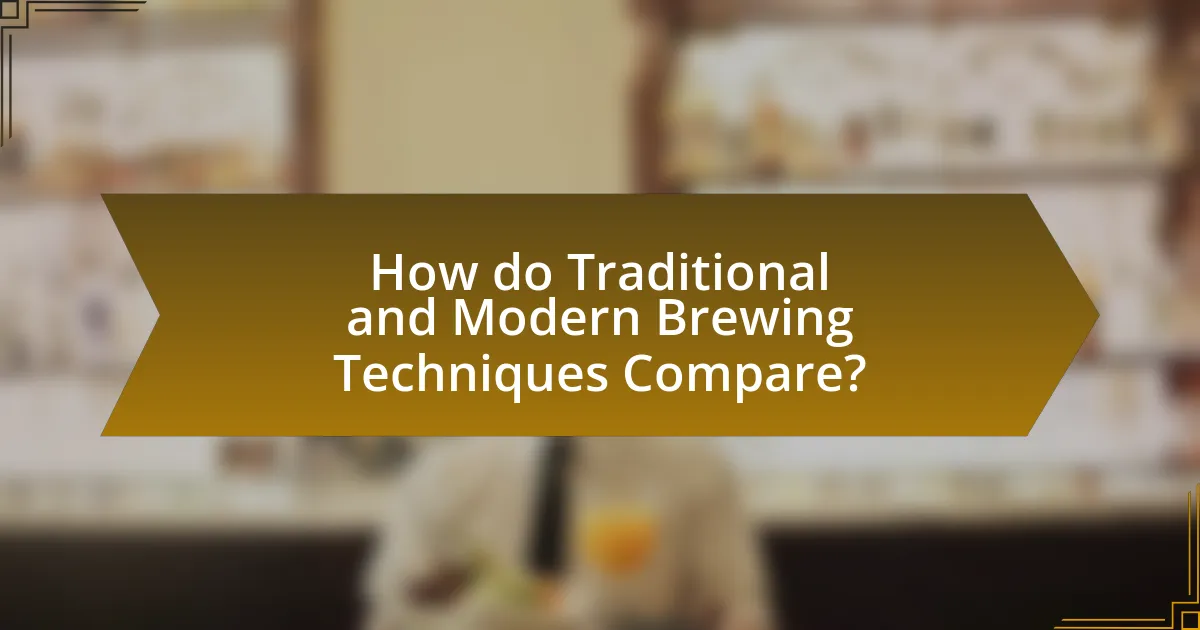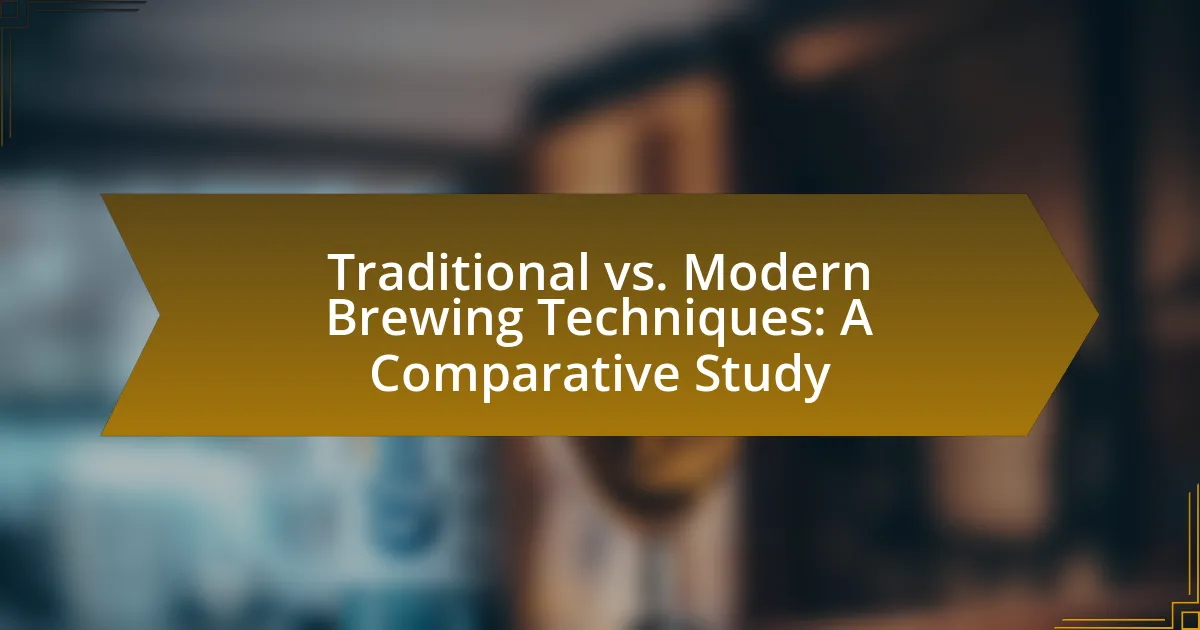The article examines the differences between traditional and modern brewing techniques, highlighting their distinct processes, ingredients, and cultural significance. Traditional brewing relies on time-honored methods and natural ingredients, resulting in unique flavor profiles and regional variations, while modern brewing utilizes advanced technology for efficiency and consistency. Key topics include the historical practices that define traditional brewing, the advantages and challenges of each method, and how brewers adapt to market demands. The article also discusses the sustainability issues associated with modern techniques and offers guidance on selecting the appropriate brewing method based on desired outcomes.

What are Traditional Brewing Techniques?
Traditional brewing techniques refer to the age-old methods used to produce beer, often characterized by the use of natural ingredients and time-honored processes. These techniques typically include mashing, boiling, fermentation, and conditioning, often employing locally sourced grains, hops, and yeast. Historical evidence shows that these methods date back thousands of years, with ancient civilizations like the Sumerians and Egyptians utilizing similar processes to create their beverages. The reliance on traditional methods often results in unique flavor profiles and regional variations, reflecting the cultural heritage of the brewing community.
How do Traditional Brewing Techniques differ from Modern Methods?
Traditional brewing techniques primarily rely on natural ingredients and time-consuming processes, while modern methods utilize advanced technology and efficiency-driven practices. Traditional brewing often involves manual processes, such as open fermentation and the use of wild yeast, which can enhance flavor complexity but require longer production times. In contrast, modern brewing employs controlled fermentation environments, automated systems, and precise temperature regulation, allowing for consistent and rapid production. Historical evidence shows that traditional methods date back thousands of years, emphasizing craftsmanship, whereas modern techniques have evolved significantly since the Industrial Revolution, focusing on scalability and uniformity in flavor profiles.
What historical practices define Traditional Brewing Techniques?
Traditional brewing techniques are defined by practices such as the use of natural ingredients, fermentation methods, and regional brewing customs. Historically, these techniques often involved the use of locally sourced grains, hops, and water, with minimal processing to preserve the natural flavors. For example, ancient civilizations like the Sumerians and Egyptians utilized simple fermentation processes, often relying on wild yeast and spontaneous fermentation, which are foundational to traditional brewing. Additionally, traditional methods often include the use of open fermentation vessels and wooden casks, which contribute unique characteristics to the beer. These practices have been documented in various historical texts, such as the “Hymn to Ninkasi,” which outlines a Sumerian beer recipe, illustrating the long-standing cultural significance of brewing.
What ingredients are commonly used in Traditional Brewing?
Traditional brewing commonly uses four main ingredients: water, malted grains (usually barley), hops, and yeast. Water serves as the primary solvent, while malted grains provide fermentable sugars and contribute to the beer’s flavor and color. Hops are added for bitterness, aroma, and preservation, and yeast is essential for fermentation, converting sugars into alcohol and carbon dioxide. Historical brewing practices have consistently relied on these ingredients, as evidenced by ancient brewing records and modern craft brewing standards.
What are the advantages of Traditional Brewing Techniques?
Traditional brewing techniques offer several advantages, including enhanced flavor complexity, cultural authenticity, and sustainability. These methods often utilize natural ingredients and time-honored processes, resulting in unique taste profiles that reflect regional characteristics. For instance, traditional fermentation processes can produce a wider range of flavors due to the use of wild yeast and bacteria, which contribute to the depth of the final product. Additionally, traditional brewing often emphasizes local sourcing of ingredients, reducing carbon footprints and supporting local economies. Historical evidence shows that many craft breweries that adhere to traditional methods have gained popularity for their distinctive offerings, highlighting consumer preference for authenticity and quality over mass production.
How do Traditional Techniques impact flavor profiles?
Traditional techniques significantly impact flavor profiles by enhancing complexity and depth through methods such as fermentation, aging, and ingredient selection. For instance, traditional fermentation processes often utilize wild yeast strains and longer fermentation times, which can introduce unique esters and phenols, contributing to a more nuanced flavor. Additionally, aging in wooden barrels can impart flavors from the wood, such as vanilla or spice, further enriching the profile. Historical evidence shows that beers brewed using traditional methods, like those from Belgium or Germany, often exhibit distinct characteristics that are less prevalent in modern, industrial brewing practices, which tend to prioritize consistency and efficiency over complexity.
What cultural significance do Traditional Brewing Techniques hold?
Traditional brewing techniques hold significant cultural importance as they embody the heritage, identity, and communal practices of various societies. These methods often reflect local ingredients, historical practices, and rituals that have been passed down through generations, fostering a sense of belonging and continuity within communities. For instance, in many cultures, traditional brewing is intertwined with festivals and social gatherings, serving as a medium for storytelling and cultural expression. The preservation of these techniques not only maintains the unique flavors and characteristics of local brews but also reinforces cultural pride and promotes sustainable practices that honor the environment and local ecosystems.

What are Modern Brewing Techniques?
Modern brewing techniques encompass advanced methods such as temperature-controlled fermentation, the use of specialized yeast strains, and innovative filtration processes. These techniques enhance flavor profiles, improve consistency, and increase efficiency in beer production. For instance, temperature-controlled fermentation allows brewers to optimize yeast activity, resulting in more precise flavor development. Additionally, the adoption of specialized yeast strains can lead to unique flavor characteristics that were not achievable with traditional methods. Furthermore, modern filtration processes, such as cross-flow filtration, enable clearer beer with reduced sediment, improving the overall quality and shelf life.
How have Modern Brewing Techniques evolved over time?
Modern brewing techniques have evolved significantly over time, transitioning from traditional methods to more advanced, technology-driven processes. Historically, brewing relied on manual labor and natural fermentation, but the introduction of scientific principles and technology has streamlined production. For instance, the use of temperature-controlled fermentation tanks allows for precise control over yeast activity, resulting in consistent flavor profiles. Additionally, innovations such as automated brewing systems and advanced filtration methods have increased efficiency and reduced the risk of contamination. The craft beer movement, which began in the late 20th century, further propelled this evolution by encouraging experimentation with ingredients and techniques, leading to a diverse range of beer styles. Overall, modern brewing techniques emphasize efficiency, consistency, and creativity, reflecting a significant shift from the artisanal practices of the past.
What technological advancements have influenced Modern Brewing?
Technological advancements such as automation, precision fermentation, and advanced filtration systems have significantly influenced modern brewing. Automation allows for consistent production and efficiency, reducing labor costs and minimizing human error. Precision fermentation technologies, including temperature control and yeast management, enable brewers to create specific flavor profiles and improve product quality. Advanced filtration systems enhance clarity and stability, ensuring a better final product. These innovations have transformed brewing practices, leading to increased production capacity and improved quality control in the industry.
What ingredients are typically used in Modern Brewing?
Modern brewing typically uses water, malted grains (such as barley), hops, and yeast. Water serves as the primary solvent in the brewing process, while malted grains provide fermentable sugars and contribute to the beer’s flavor and body. Hops are added for bitterness, aroma, and preservation, and yeast is essential for fermentation, converting sugars into alcohol and carbon dioxide. The use of these ingredients is supported by brewing science, which emphasizes their roles in achieving desired flavor profiles and fermentation efficiency.
What benefits do Modern Brewing Techniques offer?
Modern brewing techniques offer enhanced efficiency, improved flavor consistency, and greater control over the brewing process. These techniques utilize advanced technology, such as automated systems and precise temperature control, which streamline production and reduce the risk of human error. For instance, the use of computer-controlled fermentation systems allows brewers to monitor and adjust conditions in real-time, leading to a more predictable and high-quality product. Additionally, modern methods often incorporate innovative ingredients and processes, such as dry hopping and cold brewing, which can enhance flavor profiles and create unique beer varieties.
How do Modern Techniques enhance efficiency in brewing?
Modern techniques enhance efficiency in brewing by utilizing automation, precision equipment, and data analytics. Automation reduces manual labor and minimizes human error, allowing for consistent production and faster turnaround times. Precision equipment, such as advanced temperature control systems and automated fermentation monitoring, ensures optimal brewing conditions, which can lead to higher quality and yield. Data analytics enables brewers to track and analyze brewing processes in real-time, facilitating quick adjustments and improving overall workflow. For instance, breweries employing these modern techniques have reported efficiency increases of up to 30%, demonstrating significant improvements in both productivity and resource management.
What role does innovation play in Modern Brewing Techniques?
Innovation is crucial in modern brewing techniques as it enhances efficiency, quality, and variety in beer production. Advanced technologies such as automation, precision fermentation, and data analytics allow brewers to optimize processes, reduce waste, and maintain consistent flavor profiles. For instance, the use of temperature-controlled fermentation tanks enables brewers to fine-tune yeast activity, resulting in improved taste and aroma. Additionally, innovations like hop extraction methods and the development of new yeast strains expand the range of flavors available, catering to diverse consumer preferences. These advancements not only improve the brewing process but also contribute to the growth of craft beer markets, demonstrating the significant impact of innovation on the industry.

How do Traditional and Modern Brewing Techniques Compare?
Traditional brewing techniques rely on time-honored methods, often using natural ingredients and fermentation processes that can take weeks or months, while modern brewing techniques utilize advanced technology and scientific methods to streamline production and enhance consistency. Traditional methods, such as open fermentation and the use of wild yeast, emphasize craftsmanship and regional characteristics, whereas modern techniques often incorporate automation, precise temperature control, and rapid fermentation processes, resulting in quicker production cycles and uniformity in flavor profiles. For example, traditional brewing may involve spontaneous fermentation, which can yield unique flavors, while modern brewing often employs controlled yeast strains to achieve specific taste outcomes efficiently.
What are the key differences between Traditional and Modern Brewing Techniques?
Traditional brewing techniques primarily rely on manual processes and natural ingredients, while modern brewing techniques utilize advanced technology and automation. Traditional methods often involve longer fermentation times and simpler equipment, such as open fermentation vessels, whereas modern techniques employ controlled environments, precise temperature regulation, and sophisticated machinery to enhance efficiency and consistency. For example, traditional brewing may use wild yeast strains, while modern brewing often incorporates cultivated yeast for predictable results. These differences highlight the evolution of brewing practices from artisanal craftsmanship to industrial efficiency, reflecting changes in consumer demand and technological advancements in the brewing industry.
How do the brewing processes differ in each technique?
Traditional brewing techniques typically involve manual processes and longer fermentation times, while modern brewing techniques often utilize advanced technology and shorter brewing cycles. Traditional methods, such as open fermentation and natural carbonation, emphasize the use of local ingredients and time-honored practices, resulting in unique flavors that reflect regional characteristics. In contrast, modern brewing techniques leverage precision equipment, such as automated temperature controls and pressure systems, to enhance efficiency and consistency in flavor profiles. For example, traditional ales may take weeks to ferment, whereas modern lagers can be produced in a matter of days due to controlled fermentation environments. This distinction highlights the evolution of brewing from artisanal craftsmanship to industrial efficiency, impacting both the quality and variety of beer produced.
What are the taste differences between beers produced by each method?
Beers produced by traditional brewing methods typically exhibit a more complex and nuanced flavor profile, often characterized by earthy, malty, and sometimes fruity notes, due to the use of natural ingredients and longer fermentation times. In contrast, beers produced by modern brewing techniques often have a cleaner, crisper taste, with a focus on hop-forward flavors and higher carbonation levels, resulting from the use of advanced technology and precise control over fermentation processes.
For example, traditional methods like open fermentation can introduce wild yeast and bacteria, contributing to unique sour or funky flavors, while modern methods often utilize controlled fermentation with specific yeast strains to achieve consistency and clarity in taste. This distinction is supported by studies showing that traditional beers often have a broader range of flavor compounds due to less filtration and pasteurization, while modern beers tend to emphasize hop bitterness and aroma, reflecting current consumer preferences for bold flavors.
What are the challenges faced by each brewing technique?
Traditional brewing techniques face challenges such as time consumption, labor intensity, and limited scalability. For instance, methods like open fermentation require meticulous monitoring and can take weeks to produce beer, making them less efficient compared to modern techniques. Additionally, traditional methods often rely on specific environmental conditions, which can be difficult to replicate consistently, leading to variability in the final product.
Modern brewing techniques encounter challenges including high initial investment costs, reliance on technology, and potential loss of traditional flavors. Automated systems can require significant capital for setup and maintenance, which may not be feasible for smaller breweries. Furthermore, the use of advanced technology can sometimes overshadow the artisanal aspects of brewing, leading to a product that may lack the unique characteristics found in traditionally brewed beers.
How do Traditional brewers adapt to modern market demands?
Traditional brewers adapt to modern market demands by incorporating innovative brewing techniques, diversifying their product offerings, and utilizing digital marketing strategies. For instance, many traditional brewers now experiment with craft beer styles and flavors to appeal to contemporary consumer preferences, reflecting a shift towards unique and artisanal products. Additionally, they often engage in collaborations with local businesses and utilize social media platforms to reach a broader audience, enhancing brand visibility and customer engagement. This adaptation is evidenced by the rise in craft breweries, which accounted for over 23% of the U.S. beer market share in 2022, demonstrating a significant shift in consumer interest towards diverse and locally produced beers.
What sustainability issues are associated with Modern Brewing Techniques?
Modern brewing techniques are associated with several sustainability issues, primarily including high water usage, energy consumption, and waste generation. The brewing process typically requires significant amounts of water, with estimates suggesting that producing one liter of beer can consume up to seven liters of water. Additionally, modern brewing often relies on energy-intensive processes, contributing to a larger carbon footprint; for instance, the brewing industry is responsible for approximately 0.5% of global greenhouse gas emissions. Furthermore, the production of spent grains and other by-products can lead to waste management challenges, as breweries must find sustainable ways to dispose of or repurpose these materials.
What are the best practices for choosing between Traditional and Modern Brewing Techniques?
The best practices for choosing between Traditional and Modern Brewing Techniques involve assessing the desired flavor profile, production scale, and available resources. Traditional brewing techniques, such as open fermentation and the use of natural ingredients, often yield unique flavors and aromas that appeal to craft beer enthusiasts. In contrast, modern brewing techniques, including automation and advanced temperature control, allow for consistency and efficiency, making them suitable for larger production scales.
For example, a study published in the Journal of the American Society of Brewing Chemists highlights that traditional methods can enhance the complexity of flavors, while modern techniques can optimize brewing time and reduce costs. Therefore, brewers should evaluate their target market, production goals, and ingredient availability to make an informed decision between these two approaches.
How can brewers determine which technique suits their goals?
Brewers can determine which technique suits their goals by assessing their desired flavor profiles, production scale, and target market. For instance, traditional brewing techniques often emphasize unique, regional flavors and craftsmanship, appealing to niche markets, while modern techniques may focus on efficiency and consistency, catering to larger production demands. Additionally, brewers can analyze historical data on consumer preferences and market trends to align their chosen method with current demands, ensuring that their production techniques resonate with their audience.
What factors should be considered when selecting brewing methods?
When selecting brewing methods, factors such as the type of beverage, desired flavor profile, equipment availability, and brewing time should be considered. The type of beverage influences the choice of method; for instance, espresso requires a different approach than cold brew. The desired flavor profile affects the brewing technique, as methods like French press yield a fuller body while pour-over offers clarity. Equipment availability is crucial, as some methods necessitate specific tools, such as a siphon or a percolator. Lastly, brewing time impacts the method selection; quick methods like Aeropress are suitable for those with limited time, while traditional methods may require longer steeping periods. These considerations ensure that the chosen brewing method aligns with the intended outcome and available resources.
